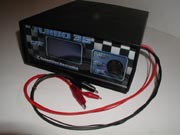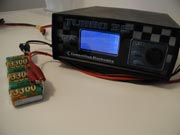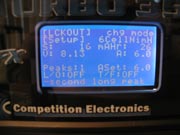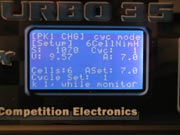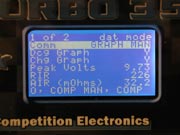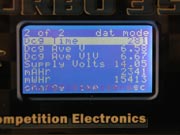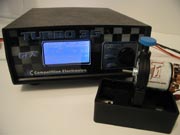
Competition Electronics Turbo 35 GFX (reviewed by futureal)
Introduction
Over the years, Competition Electronics' line of Turbo chargers has quietly become the defining edge of
battery charging technology in the R/C industry. Beginning with their still-popular Turbo 30 charger,
and extending to the more recent Turbo 35 edition, more experienced racers tend to use CE chargers
than any other brand. Recently, other companies have begun to release comparable systems to CE's,
but none have been able to match the popularity of the Turbo 30/35.
Now, after making its debut at last year's International Hobby Expo, the new Turbo 35 GFX has hit the market.
Sporting a completely redesigned interface, a larger, backlit display, higher amp rates and a wide
range of small improvements and additions, the GFX has raised the bar for battery charging systems
everywhere.
Features
The Turbo 35 GFX package includes the charger, alligator clips for the power supply and charging leads,
a 12-page manual and a Competition Electronics sticker sheet. Here's what the charger has to offer:
- Microprocessor-based charging/discharging system
- Large backlit display (colors can be inverted)
- Ten charging profiles which can be saved to and loaded from memory
- Supports charging/discharging of 1-8 cells
- Supports charge rates of up to 12.0 amps
- Supports discharge rates of .5 to 35 amps for 1-6 cells,
.5 to 25 amps for 7 cells and .5 to 20 amps for 8 cells
- Supports "TurboFlex" (reflex) charging at variable intensity levels from 1-9
- Supports motor runs up to 20 amps
- Real-time charge and discharge graphs may be displayed
- Displays discharge data such as time and average cell voltage
- Cycle mode allows automatic charge, peak and discharge of up to 8 cells
- Cycle mode records (and graphs) all data including relative internal resistance
- Reads pack voltage down to 1 mV for readings below 2 volts
- Optional audible feedback for key presses, charge/discharge and cycle completion
- Serial interface for use with HyperTerminal and CE's TurboLabel software
The Turbo 35 GFX requires an external 12 to 16 volt, 20 amp or higher DC power source. Power supplies with
fewer amps may be used, but charge rates and motor runs will be limited to the supply's capacity.
Out of the Box
The GFX comes with the power supply and charging leads un-soldered, so you can connect it to your equipment
however you'd like. I went with the "standard" setup: alligator clips on the charging leads, and an Astroflight-style
connector for the power leads. Since I have used Turbo 35s for some time, I have my Rivergate Bulldog power
supply set up with the plugs to allow easy connection and disconnection of my chargers.
I do recommend reading the included instruction manual thoroughly before beginning operation of the charger. The
manual lacks pictures, so the text may be overwhelming to a first-time user, but I guarantee that the information
you are looing for is there. CE has provided a detailed guide to the charger, even covering some of its more
obscure features such as connecting an ASCII-capable printer for the direct output of discharge data.
Once the leads are soldered, the charger is ready for use; just plug it into the power supply and you're ready
to go. The GFX includes default profiles for many of the common battery types: 6-cell and 4-cell packs, transmitter
packs and so on. You will want to check with your matcher for their recommended charging settings depending on what
type and brand of batteries you are using (NiCad or NiMH; Sanyo, Panasonic, Gold Peak, and others). Changing the
amperage and peak detection settings has never been easier, either. Using the rotary wheel on the front of the GFX,
the settings can be scrolled through and modified, and some (such as the amps) can even be changed on-the-fly during
a charge.
When connecting the GFX (or any Turbo 30/35 unit) to a battery, it is very important that the voltage sensing leads
be used, and used correctly. I have heard all sorts of myths and explanations from racers regarding these leads and
their use. I've heard that they are "calibrated" based on their length (false), that they don't do anything (false),
and that soldering them directly to the charging leads is the best thing to do (also false). As explained by CE,
when the current jumps from the battery terminals to the charging leads, there is a measurable voltage drop. Using
discharging as an example, this would typically be equivalent to .30 volts at a 30A rate, meaning that a 6-cell
pack would cut off at 5.70 volts, rather than the intended 5.40. Many, many people connect the sensing leads to the
charging leads, which renders them useless, since they are then measuring the current after the drop occurs. To
maintain accuracy, the sensing leads should be connected to something that is soldered directly to the battery.
Performance
The best thing I can say about the Turbo 35 GFX is that it does exactly what it's supposed to do, and does it well.
I wouldn't say that the GFX is loaded with bells and whistles, but it does have a wide variety of features, many more
than the majority of us will ever use.
The most important function, of course, is the charging and discharging of batteries. I found the
GFX's charging modes to be easier to navigate and set up than the Turbo 35, often requiring far fewer key presses
to accomplish any one task. Even better is the inclusion of the mAHr display on the charge screen, which makes it
much easier to visualize a false peak before it's too late. This is especially useful if you use different types
of batteries, where just comparing seconds doesn't necessarily tell you if your pack is fully charged or not. Other
improvements include the "Lockout" and "TurboFlex" indicators on the charge screen, once again helping to prevent you
from mis-charging something.
Discharging and cycling both work as advertised, with the latter collecting a variety of information that can be displayed
or output in various ways. One of the coolest features of the GFX is its ability to interface with the HyperTerminal
program included with Microsoft Windows, as a means for saving cycle data without having to have the TurboLabel
software. For the first time, I think people might really start using the data ports on their chargers!
The GFX now supports motor runs of up to 20 amps, which is another welcome feature, and one that sets the charger
apart from many other comparable systems from other manufacturers. To my knowledge, there is no other charger
available in the US that can handle charging, discharging, cycling and motor runs to the level that the GFX
can.
My only complaint with the GFX's performance has to do with the rotary wheel. I like it, but I found it to be a bit
too sensitive when trying to scroll through values, especially when changing a YES/NO setting like the Long Lockout.
I had to be extra careful to get it to turn just far enough to get to where I wanted to go. A minor bug, but a bug
nonetheless.
The Verdict
I won't sugar coat it: the Turbo 35 GFX is one of the most expensive pieces of R/C equipment you may ever
buy. And yet, you should still buy it, because there is simply no better charging system available today.
The GFX can handle everything you're likely to throw at it, from NiMH to NiCad batteries, motors to comm lathes, cycling
and even battery matching. This charger does it all.
Add that to the fact that Competition Electronics has a reputation for excellent service, and you can't go wrong with
the GFX. It may very well be the last battery charger that you'll ever have to buy... at least, until CE comes out with
their next one.
|
Likes
- Unparalleled feature list
- Outstanding performance
- Large, bright, backlit display
- More data than you'll know what to do with
|
Dislikes
- Expensive
- Rotary wheel is overly sensitive
- Larger than most other chargers
|
Tech Rating
Quality:
Performance:
Manual:
Value:
Overall:
|
|
  
  
  
  
  
|
|
10
10
9
9
9.5
|
|
